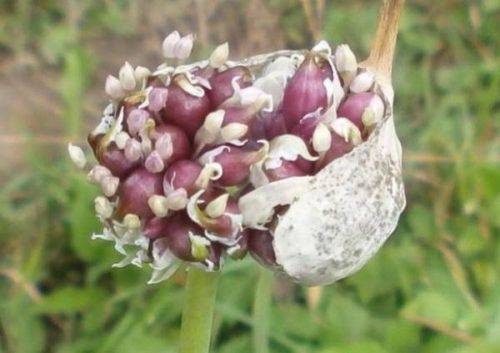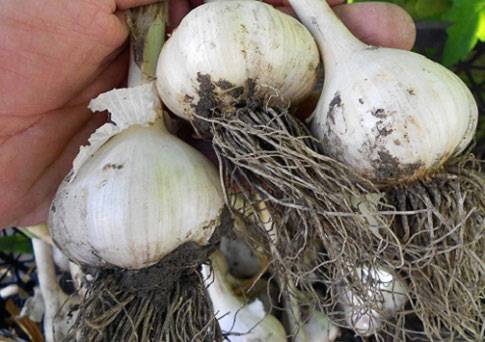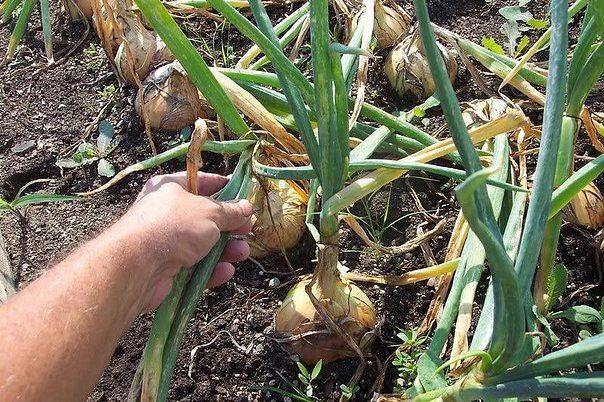Content
Every gardener dreams of growing a rich harvest of various vegetables, including onions and garlic. When applying agrotechnical principles, even a beginner can cope with this. But getting a large number of useful heads is half the battle. After all, the products still need to be preserved until the new harvest.
Novice gardeners are often interested in dig up garlic and onions, so that during storage they do not lose their presentation, dry out or rot. We will try to answer these questions in the article. Since only ripe vegetables are perfectly stored, you need to choose the optimal time for harvesting from the beds.
Determining the timing of garlic harvesting
General information
Two types of garlic are grown in household plots and summer cottages – winter and spring. One is planted before winter, the other in spring. Since planting dates are different, vegetables are not harvested at the same time.
In addition, maturation will depend on the following factors:
- region of residence of the gardener;
- current weather conditions;
- varietal differences;
- implementation of agricultural technology.
Although there are a number of general nuances, thanks to which you can determine the readiness of garlic for harvesting:
- the husk is easily removed;
- yellowing of the stem and tops begins from the bottom up;
- the heads are dense, without cracking, the cloves separate well.
Winter garlic
It is more difficult to decide on spring garlic. But the bulbs on the arrows allow you to recognize the ripeness of winter varieties. As soon as they appear from under the cover, the garlic is ready for harvesting. It is not advisable to leave arrows on all plants, since the cloves turn out to be small. But on several garlic crops they are necessary as guidelines for harvesting.
Spring garlic
Garlic planted in spring is called spring garlic. Cloves are planted in the ground at the end of April, beginning of May, while the activity of the onion fly is minimal.
Determining the timing of harvesting is easier for those gardeners who plant winter crops varieties of garlic. As a rule, the turn for spring plantings occurs in two or three weeks.
You can visually understand that a vegetable planted in spring is ripe by the following signs:
- the leaves located at the base of the stem become yellow;
- the stem and upper leaves lose their brightness, but still remain green.
Spring garlic is harvested in the last ten days of August, early September. It all depends on the climatic conditions of the region.
Regardless of whether spring or winter varieties are planted, they must be dug out before the jacket on the head cracks. If the cloves have separated from each other, such garlic is not suitable for storage. You can check when to dig the bulbs out of the garden bed by pulling one or two plants out of the ground. If the head has formed, then it’s time to remove it.
Secrets of gardeners
Weather is an unpredictable phenomenon. If it rains, the ripening of garlic slows down due to the abundance of moisture before harvesting.Plants remain green for a long time and may produce new roots, which will negatively affect the quality of the crop and its keeping quality.
What can you do in this case:
- select soil from under the plants, exposing the heads;
- tie the greens into knots so that nutrients flow into the bulb.
If at this time the heads have formed and the tops remain green, it is best to dig up the garlic without cutting the stem. The harvested crop is removed to a ventilated room and left to ripen. Over time, the leaf will release nutrients and turn yellow.
Harvesting onions
Onions, as well as garlic, need to be harvested in a timely manner. Overripe bulbs do not store well. How do you decide when a given vegetable is ready to be dug up?
Firstly, about harvesting onions You need to take care already during planting the seeds - remember the number. As a rule, the bulbs ripen 70-75 days after planting.
Secondly, the external condition of the plant will tell you when to dig up the onions. The feather begins to turn yellow, the neck becomes soft. After a while, the stem lies down. This is a signal of bulb ripening.
Of course, it is impossible to name the exact number of onion harvests, since climatic and weather conditions also affect the ripening process. In rainy summers, the growing season is extended; in droughts, on the contrary, it is shortened.
They begin harvesting onions from the garden in the last ten days of July. Harvesting the entire onion plantation should not take more than 10 days, otherwise the bulbs will overgrow.
Important points
The question “onions and garlic, when to remove” is often typed by users in search programs.This is really important to know. We will continue the conversation on this topic.
- The fact is that both vegetables stop watering 2-3 weeks before harvesting. This is a necessary procedure. It is necessary to slow down the development of the plant and accelerate ripening. When watered or during a rainy summer, almost ripe onion and garlic bulbs may begin a new growing season and roots may appear. This not only slows down the ripening of vegetables, but will further reduce the quality and keeping quality.
- Know onion harvesting time And garlic is also needed because vegetables are dug up in dry, sunny weather. Therefore, if prolonged rains are expected, then you need to remove vegetables from the garden before the weather gets wet. They will have time to ripen in a ventilated area.
Useful tips instead of summaries
- In sunny weather, dug up onions and garlic are laid out on beds so that they dry and the earth falls off them. You can keep onions all day, but garlic for no more than 3 hours.
- When garlic and onions are ready for harvesting, the top scales rustle on them.
- Bulbs and garlic heads should be dried in breezy rooms.
- Vegetables harvested in a timely manner are trimmed after the stems and leaves are completely dry.
- It is easy to speed up the ripening process under unfavorable conditions: lightly dig up the plantings with a fork to shorten the root system.
How to determine the readiness of onions and garlic for harvesting:













